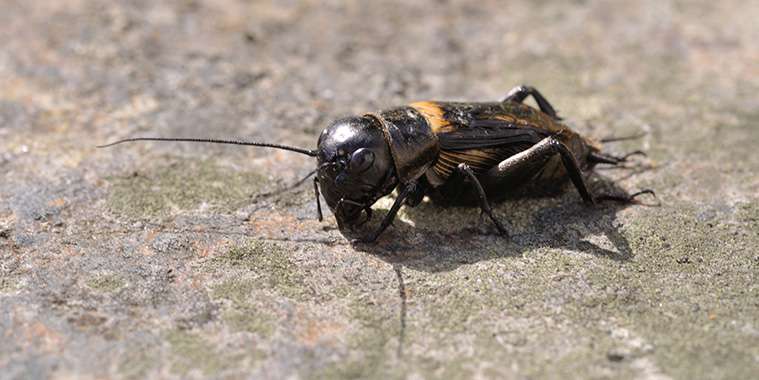Summer wouldn’t be summer without the life-affirming sounds of crickets chirping well into the night. But let’s ditch that idyllic scene: Fact is, these raucous insects can infest your home and make life miserable. And once they figure out how to get inside and multiply into an army, getting rid of your unwanted house guests can become a war.
These common pests are recognized for their loud chirping, but that’s not the only threat they pose once they get inside the house. “They can cause property damage, specifically to clothing, carpets, and other areas covered in fabric,” says Jim Fredericks, PhD, chief entomologist for the National Pest Management Association (NPMA).
The two most common crickets found inside households are house crickets and camel crickets, according to Fredericks. House crickets have long antennae, six legs, and measure from about three-quarters to seven-eighths of an inch in length. Camel crickets, on the other hand, get their name from their humpbacked appearance and use their long limbs to jump to great heights. Both can drive you absolutely bonkers.
Whether you’re grappling with an infestation or are mounting your defense against them, here are some simple tips on how to get a handle on crickets in your house this summer.
1. Go old school, with molasses
Your grandma’s molasses is a tasty ingredient in cakes, cookies, and candy, but it can also work as excellent bait for crickets. Mix three to four tablespoons of molasses in half a bowl or a jar of water. Place this trap in various parts of your house. The sweet scent of molasses is so hypnotizing to crickets it will lure them to jump in and drown. (Sorry, cricket lovers.)
2. Keep your yard trimmed and neat
Maintaining the outside of your house is also a good preventive measure. Chelle Hartzer, board-certified entomologist, recommends making sure that trees and bushes are neatly trimmed back and that areas near your home are not overwatered.
“Additionally, store firewood at least 20 feet away from the house, regularly mow tall grass, and keep trash cans away from thte house, as these are all common outdoor cricket harborage sites,” says Fredericks.
3. Sprinkle some diatomaceous earth
Diatomaceous earth (DE) is a fancy-schmancy scientific name for a white powder that is created from the skeletons of algae. When insects come in contact with DE, they become dehydrated and eventually die. Found in home improvement or garden stores, DE is safe to use around people and pets and can be sprinkled indoors and outdoors in crevices where there’s a cricket problem.
Make sure to get food-grade DE, and only use the powder in dry places. If it gets wet, it won’t be effective.
4. Grow nitrogen-fixing plants
Crickets are also inclined to feast on young plants or flowers. To prevent them from chowing down, experts suggest planting nitrogen-fixing plants, which draw nitrogen gas from the air and store it in their roots. These include peas, beans, and legumes. Planting garlic, clover, cilantro, sweet potatoes, and sweet peas in your garden can also irritate crickets and drive the bugs out.
5. Shut down entry points
Prevention is key. Keeping your home clear of crickets starts with blocking all entry points. Hartzer says it’s especially important to seal the gaps between the bottom of doors and the floor. “Don’t forget garages, too! Once crickets get into a garage, that often allows them further access to get in the house,” says Hartzer.
Both cricket species are attracted to moisture, so Fredericks advises eliminating moisture buildup by ventilating crawl spaces and basements and repairing any leaking pipes or air-conditioning units.
6. Let natural predators do their thing
Crickets are easy prey for other animals. Cats and dogs follow their natural instincts and will patrol their territory, including happily clearing your home of crickets. Place a bird feeder in your garden for even more help, as birds will chomp on any cricket in sight. Lizards and even spiders are natural cricket predators, too.
7. Make a natural pesticide
To keep crickets from eating away at your garden, make a spray of fresh hot chilis and/or hot chili powder dissolved in two cups of water and a few drops of dish soap. Wearing protective gloves, glasses, and a mask, spray toward (but not directly on) plant leaves and soil. The hellfire burn will keep them away. Crushed garlic cloves can also be added to the chili mix for a more potent blend.
— realtor.com


